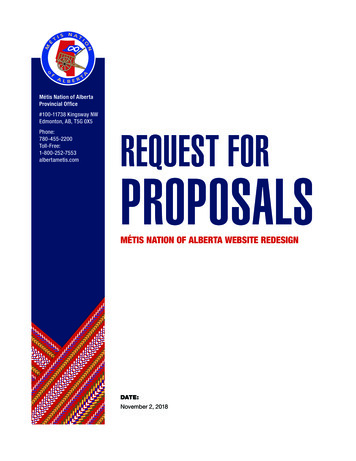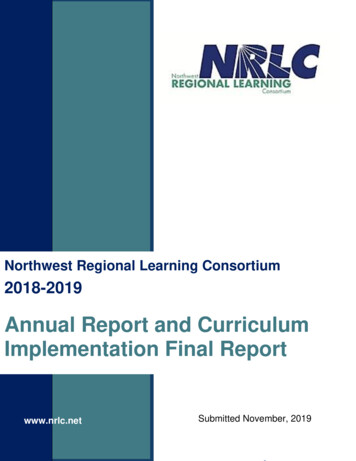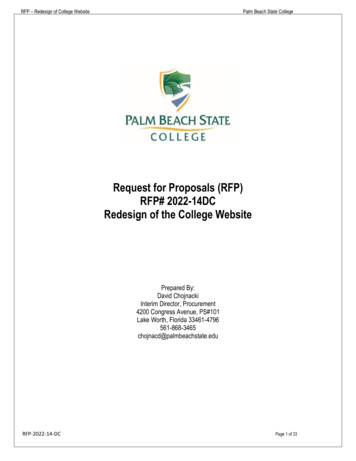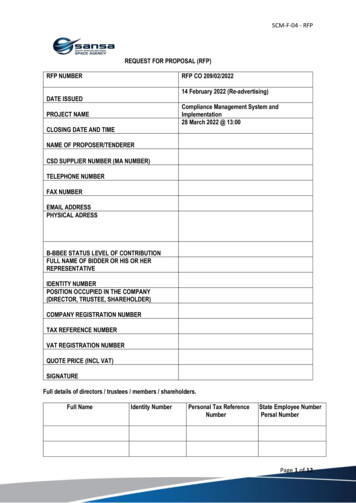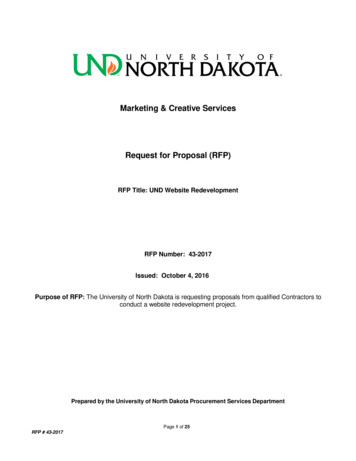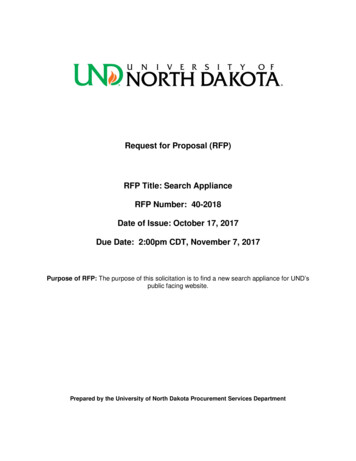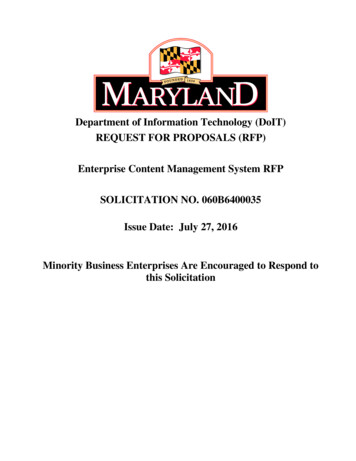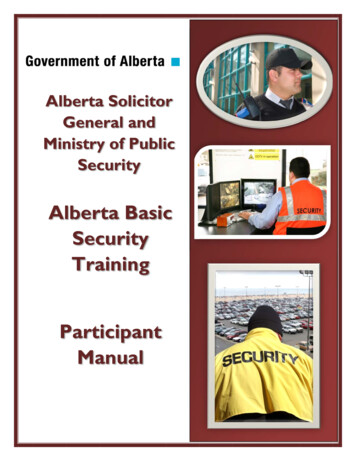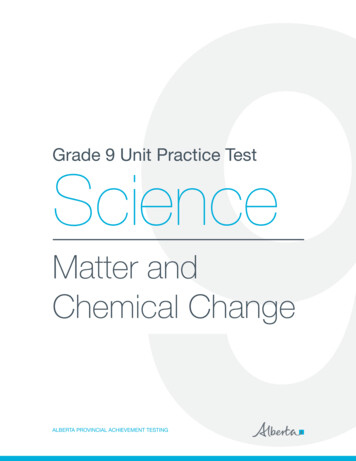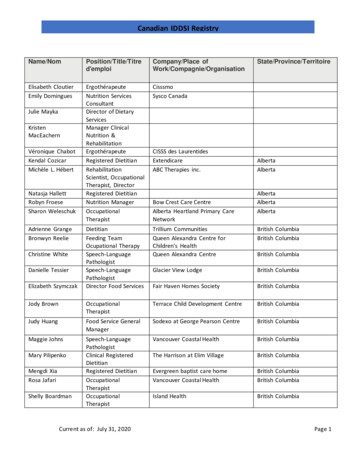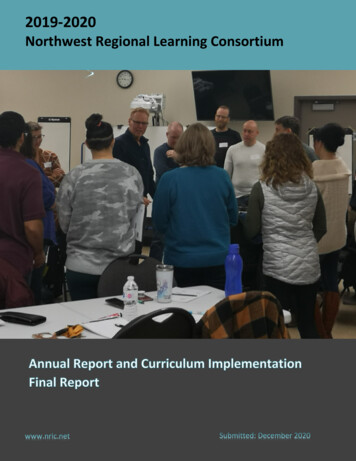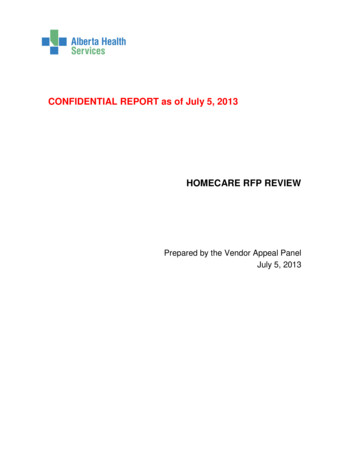
Transcription
CONFIDENTIAL REPORT as of July 5, 2013HOMECARE RFP REVIEWPrepared by the Vendor Appeal PanelJuly 5, 2013
TABLE OF CONTENTS1. BACKGROUND. 32. RFP PROCESS CONCERNS . 103. CONGREGATE LIVING SETTINGS . 25APPENDIX A: REVIEW TERMS OF REFERENCE . 31APPENDIX B: RFP RESULTS BACKGROUNDER . 36APPENDIX C: SUMMARY OF PROPOSALS RECEIVED . 43APPENDIX D: SUMMARY OF UNSUCCESSFUL PROPONENTS FOR CONGREGATE LIVINGENVIRONMENTS . 51APPENDIX E: MEMO RE CHANGES TO HOMECARE DECISIONS . 54APPENDIX F: OVERVIEW OF THE RFP PROCESS . 55APPENDIX G: HOME CARE RFP SCORING GUIDE . 62APPENDIX H: SUMMARY OF VENDOR COMPLAINTS . 88APPENDIX I: APPEAL LETTERS . 94Vendor Appeal PanelDr. Verna Yiu, EVP & CMO Quality & Medical Affairs, AHS (Chair)Dr. J. Lawrence Tymko, Chair Health Advisory Council, Edmonton ZoneDr. John Cowell, CEO Health Quality Council of AlbertaCharlene McBrien-Morrison, Executive Director, Health Quality Council of AlbertaDavid Breakwell, ADM Corporate Services, Ministry of Health, Government of AlbertaDavid Handley, Executive Director, Lower Mainland Business Initiatives & SupportServices, Vancouver Coastal Health AuthorityAllan Sinclair, Executive Director, AHS Central ZoneSteve Fowler, Director, AHS Capital Management(Homecare RFP Review)2(July 2013)
1. BACKGROUNDBackgroundIn November 2011, a Homecare Contract Risk Assessment identified a number of highrisks related to current Home Care contracts. Overall the risk rating for these contracts wasassessed as Moderate. The following key risks were identified:Current contract terms vary across zones and the province, so the quality andassurance accountabilities are not consistently stipulated to the service providers.Current variations in existing contracts allow for inconsistent levels of service fromcontracted providers.An inconsistent funding model has resulted in a lack of parity in payment terms toproviders across the Province with rates ranging from 22/hr to 32/hr.The financial viability of certain service providers (due to low reimbursement rates)may be at risk.Imbalance between number of contracted agencies and case management staff.Large number of providers in certain zones (Edmonton) which increases themonitoring costs.Homecare StrategyThe results of the risk assessment were considered along with the provincial HomecareRedesign Strategy and used to develop a Homecare RFP strategy. The provincialHomecare RFP strategy included the following elements:Standard contractsConsistent funding modelStandard variables in the following areas:o Defined service areas based on geography, site or specialtyo Reimbursement parameters: minimum service time/travel support (time vs.distance)o Performance Standards/Service Delivery Expectations Staffing, essential services, non performance recovery Accreditation Quality Assurance reporting requirements Policy, guidelines, standards requirements, differences in client mix(levels of service required, etc) and licensing requirements forfacilities.Scope and Terms of RFPThe scope of the RFP was intended to address several of the elements of the provincialstrategy outlined above including:Standard contractsDefined service areas based on geography, site or specialtyConsistent performance standards and service delivery expectationsOptimize the number of service providers in the Edmonton Zone (ideally reduce thenumbers)Included within the scope of the RFP were all home care services within the EdmontonZone and all community based home care services in the Calgary Zone. Home Care(Homecare RFP Review)3(July 2013)
Services in Calgary delivered in facilities were still under active contracts so were notincluded in the scope of the RFP. It was also decided not to include the three rural zones inthe RFP. Three unique service providers in Edmonton zone were also excluded from theRFP.The key criteria set out in the RFP for the selection of vendors are detailed in Appendix Fand fall into the following categories:Technicalo Corporate profile and quality assuranceo Service deliveryo Staffing and sustainabilityo Transition plano InnovationFinancial viabilityFinal selection criteria assuming above criteria are meto Service delivery considerationso Service capacityo Pricing and other efficiencieso Preference rankingEach of the Edmonton and Calgary Zones were divided into Geographic Service Areas(GSA) within which may include congregate living environments (CLE). A congregate livingenvironment is a multi-residential facility whose residents receive home care services andother services such as supportive living. Proponents could submit proposals for anycombination of GSAs. Each GSA less any CLE’s contracted to owner-operators would beserved by only one provider. However a provider could be successful in obtaining contractsfor more than one GSA. Owner-operators of CLEs could submit proposals for their facilitiesseparately. Provided they met all of the RFP criteria as outlined above, they couldreasonably expect to obtain a homecare contract for their clients.RFP processThe review of the homecare contracts began in 2011 with a risk assessment and marketanalysis. In 2012, the development of a provincial home care strategic plan was begun anda project charter and steering committee was established in December 2012 for thehomecare RFP process. Throughout this process, there was engagement with internal andexternal stakeholders to develop the business requirements for the RFP, standard masterservice agreements to be used, etc.In early 2013, Alberta Health Services put out a Request for Proposals for Homecareservices in Edmonton and Calgary. The RFP process was concluded in May with thedecision on awarding contracts made in June and released to the public in June.Timelines for the RFP were as follows:ActionNotice letter to providersRFP PostedSubmissions DueBriefing Note to AHS ExecutiveBriefing Note to Alberta Health(Homecare RFP Review)DateDecember 5, 2012February 7, 2013February 28, 2013May 9, 2013May 9, 20134(July 2013)
Executive Committee ApprovalAudit & Finance Committee ApprovalLetters of Intent to Successful Vendors(subject to Board Approval)Notification to Unsuccessful VendorsBoard ApprovalClient LettersMay 14, 2013May 23, 2013May 28, 2013May 30, 2013June 5, 2013June 10, 2013All RFP proposals were evaluated using the same criteria,. Stage 3 of the process involveddetermining the appropriate mix of service providers. The Committee considered severaloptions to identify sufficient qualified service providers to provide adequate and quality care,while at the same time managing service delivery continuity risk and improving costeffectiveness of the system. Based on the modeling scenarios, 5 to 7 community providerswas viewed to be a good number to provide a reasonable client base for service providersand the best value for AHS.This was confirmed throughout this review process and by the Fairness Monitor. Thecommittees and staff conducting this process followed a rigorous approach and adhered tothe key principles and criteria established at the outset of the RFP process.During the process Executive and AH were briefed on the decision to proceed with the RFPprocess and award contracts; however, it is not clear from the information reviewed if allstakeholders understood some of the significant issues that the Committee consideredduring its deliberations and the analysis/basis for these decisions.Results of the RFPThe following table summarizes the number of proposals received under the RFP and thenumber that were ultimately garyTotalCommunityEdmontonCalgaryTotalTotalNumber of proposals that passed:MandatoryBoth(100% ofFinancialTechnicalNumberProponents) Technical Viability and Financial 1061622661218Notes:1. Some vendors applied to both Edmonton and Calgary, and some for both Community andCongregate Living Environments, thus the totals above do not represent unique proponents.(Homecare RFP Review)5(July 2013)
2. The one proponent who submitted their proposal late and was disqualified from the RFP processis not included in the above table.The following table summarizes the status before the RFP:Number of providers beforethe RFPContract value before theRFPAfter RFPEdmonton ZoneCalgary Zone35 (3 providers not included 10in the scope of the RFP) 64 million 45 million107Some vendors applied to both Edmonton and Calgary, and some for both Community andCongregate Living Environments, thus the totals above do not represent uniqueproponents.It is expected that AHS will save 18.5 million annually to be reinvested in health careservices from this contracting process.The following table summarizes the successful proponents on the RFP. There are 13 homecare providers (three not-for-profit and 10 for profit). A further breakdown of these providersbetween for profit and not for profit organizations is contained in Appendix B.Proponent nameDiversicare Trinity LodgeCityCalgaryRosedale PartnershipEdmontonShepherd’s Care FoundationEdmontonSt Michael’s Health GroupEdmontonUnited Active LivingEdmontonCanterbury FoundationEdmontonBayshoreReveraCBI Home HealthCBI Home Health – GEFCBI Home Health – SilveraCaregivers Home HealthWe CareClassic LifecareCalgary and EdmontonCalgary and EdmontonCalgary and EdmontonEdmontonCalgaryEdmontonCalgary and EdmontonCalgaryNatureCongregate LivingEnvironmentCongregate LivingEnvironmentCongregate LivingEnvironmentCongregate LivingEnvironmentCongregate LivingEnvironmentCongregate ityCommunityCommunityCommunityCommunityMost home care clients will not see any change in their providers. About 10 percent ofCalgary clients and about 30 percent of Edmonton clients will be transitioned to a newprovider.(Homecare RFP Review)6(July 2013)
Home Care Clients per zone (January 2013)ZoneTotal # of home care # home care clientsclientswho receive carefrom a 7,512# of home care clients who willtransition to a new contractedprovider1,3484,713The Committee understood that there would be a significant effort required to manage thetransition of clients to new caregivers and assuring quality of care throughout the process.Transition plans were developed to ensure a smooth transition. The team understoodtransition risks and issues related to staff movement and recruitment and considered thesefactors in determining the final model and the final contract award decisions. Existingcontracts were extended to July 31, 2013 to allow for the transition.The transition to new service providers is currently underway. There have been minimalclient concerns/transition issues in Calgary. The Edmonton Zone has experienced moreissues due likely to two factors: the larger number of clients that are transitioning to newproviders and the requirement to stop transition until the appeal is concluded.Committee members have highlighted that we need to ensure that when we undertakesignificant change processes like this RFP that the whole organization and keystakeholders agree on the strategy and are committed to honour the results. The SteeringCommittee and working groups have spent over 18 months of efforts to complete thisprocess and it took significant resources and difficult decisions were required. The teamsfocused on doing the best job possible in the interests of clients and AHS.Vendor complaintsSubsequent to the release of the decisions to award contracts, a number of concerns wereraised by clients who would be impacted by the change in services and by vendors whowere unsuccessful in the RFP process. As a result of some public response to the results ofthe RFP, AHS after consultation with affected stakeholders reversed the decision to changeproviders for three cooperatives.The concerns raised by the vendors generally fall into the following two categories:1. Vendors who had issues with the RFP process, alleging that it was not fair ortransparent or otherwise had deficiencies. Details of these complaints arecontained in Section 2 and Appendix H but can be summarized as:Inconsistent treatment of integrated sites between Edmonton and CalgaryLack of clarity on some of the key criteria used in the RFP decision makingprocess such as the desire to reduce the number of providers and qualityconsiderationsThe financial evaluation process did not properly include the financialposition of both parent and subsidiary companies(Homecare RFP Review)7(July 2013)
Inconsistent treatment of proponents related to the ability to negotiate priceTiming of communications about the pending RFP and inadequate timelinesto respond to the RFP2. Several vendors and stakeholders disagreed with the perceived change to theservice delivery model for those clients living in Congregate Living Environments.These vendorsoperate congregate living facilities in Edmonton where most hadpreviously provided site-based homecare services as well as supportive livingservices (under separate contract with AHS) to residents of their facilities. Thesevendors believe change to geographically based service providers for home careservices to clients in their facilities will negatively impact their clients and for avariety of other reasons was a poor decision from a service delivery and patient careperspective.A summary of the issues raised by the vendors is in Appendix H. A summary of thecomplaint letters is attached in Appendix I. Copies of the written complaints received werealso shared with the Vendor Appeal Panel.Review ObjectivesThe objectives of the review were to:Determine whether there is any substance to the concerns raised by vendors withrespect to the RFP process, andReview the process and decisions related to home care service delivery forcongregate living facilities and provide advice.In support of the project objectives, the audit team:Reviewed all relevant documentation related to the RFP, the RFP process and thefinal decision.Interviewed individuals who had a key role to play in developing the RFP or in theRFP process. This included the Fairness Monitor engaged for the RFP.Interviewed individuals who had a key role to play in determining the servicedelivery model for the Edmonton Zone.Interviewed the following six vendors who had submitted appeals to the RFP:ooooooFairness MonitorAHS engaged a Fairness Monitor (FM) for the RFP process to ensure that it was fair andtransparent. Internal Audit reviewed the FM’s report and interviewed the FM. Internal Auditalso reviewed the process AHS used to select the FM, including the process to assess thequalification of the FM, and to ensure the FM had no conflicts of interest that couldnegatively impact their involvement in the RFP process. As a result of this process, InternalAudit was able to conclude that it could rely on the work of the FM while performing thisreview.(Homecare RFP Review)8(July 2013)
The FM’s conclusion on the RFP as contained in their report dated June 20, 2013 was:In consideration of the above, having served as the Fairness Advisor during theconduct of the RFP No. SER2013-02-8091 as described herein, up to andincluding the identification of the successful Proponents (as affirmed on May 3,2013 by the AHS Home Care Steering Committee) and having reviewed thesolicitation documents and evaluation and selection process associated with eachof Stage 1, Stage 2, and Stage 3 of the procurement process:We are of the opinion that the process which resulted in the determination of thefollowing 13 successful proponents at the conclusion of Stage 3, was conducted ina manner which was consistent with the principles of fairness, and that theseoutcomes are an accurate reflection of the process and decisions of the AHSevaluation team.Shepherd’s Care FoundationRosedale PartnershipSt. Michaels Health Care ServicesCanterbury FoundationUnited Active Living Inc.Diversicare Canada Management Services Co., Inc.Bayshore Healthcare Ltd., o/a Bayshore Home HealthRevera Health Services Inc., o/a Revera Home HealthCBI Home Health (AB) Limited PartnershipCaregivers Home Health Care Inc.524173 Alberta Ltd. o/a We Care Home Health ServicesDignity Health Care Ltd. o/a We Care Health Services CalgaryClassic Lifecare Ltd.A copy of the FM’s report was shared with the Vendor Appeal Panel.(Homecare RFP Review)9(July 2013)
2. RFP PROCESS CONCERNSThe following is a summary of the key issues raised by the complainants related to the RFPprocess along with information obtained by Internal Audit in its review of the issues, andconclusions on each issue.1. Inconsistent Treatment of Integrated Sites Between Edmonton and CalgaryIntegrated sites in Calgary did not have to submit a response to the RFP while sites inEdmonton did and that the process was therefore not fair.Information Obtained by Internal AuditThere are differences in the service delivery models as a result of historical practices in theEdmonton and Calgary Zone related both to service delivery models and contractingpractices.In Calgary, homecare services offered in supportive living facilities may be considered partof supportive living services and not homecare services under an integrated servicesmodel. This is a different service delivery model than what is used in the Edmonton Zone.There are currently 9 providers that provide integrated services under this model in theCalgary Zone. There are also Community providers that provide homecare services in 10CLEs in Calgary, of which 2 also have supportive living services provided by anotherprovider (100 clients).In 2007, the Calgary Zone issued an RFP for the provision of integrated services (includingthose which would be classified as homecare services in the Edmonton Zone). Thecontracts for integrated care services in Calgary have not yet expired therefore thesefacilities were not included in the scope of the 2013 homecare RFP. These contracts expirein 2016 with a one year option to renew.Edmonton has historically not used a geographic service delivery model and has a highnumber of providers delivering home care services in the community. In congregate livingenvironments, providers have separate contracts for home care and supportive livingservices. There are currently twelve sites in the Edmonton Zone where home care servicesand supportive living services are provided by two separate service providers.As a result, the RFP always had the potential to result in two providers delivering serviceswithin the same facility. This was recognized during the planning for the RFP but theimpacts to the providers and clients were considered to be manageable at the time.Most providers indicated in their complaint letters (See Appendix I) and in interviews thatthey considered the integrated model used by Calgary to be preferable in that it resulted inbetter, more consistent care for clients, offered providers efficiencies, better integratedservices and was logistically more manageable within their facilities.In discussion with the Fairness Monitor, Internal Audit learned that it is a business decisionas to the scope of an RFP and what should be included and what should be excluded. As(Homecare RFP Review)10(July 2013)
long as the scope of the RFP is clear, which the Fairness Monitor indicated it was in thiscase, the exclusion of the integrated Calgary sites did not compromise the integrity of theRFP process.Audit Conclusions:The Calgary integrated sites had contracts awarded as a result of an RFP in 2007 andthese contracts are not due to expire till 2016. As a result, these sites were excluded fromthe scope of the RFP.Audit Advice:For future RFPs, management should consider more effectively communicating the scope,and reasons for the determination of the scope, of RFP’s to proponents to ensure theopenness and transparency of the RFP process.Vendor Panel Decision and Recommendations:The panel concluded that the RFP scope was a business decision and the scope of theRFP was clearly communicated. In addition, Calgary contracts had not yet expired andtherefore were not eligible to be included in the RFP.2. AHS Did Not Disclose Desire to Reduce Number of Edmonton ProvidersAHS was not forthcoming with their intention to reduce the number of service providers as aresult of the RFP and, had vendors known this, they may have changed their RFPsubmissions.(Homecare RFP Review)11(July 2013)
Information Obtained by Internal AuditThe number of successful proponents and/or the desire to reduce the number of serviceproviders was not a formal criterion of the RFP. However, it was clear in the RFPdocuments that only one provider could be successful for each Geographic Service Area(although more than one Geographic Service Area could be awarded to an individualprovider) and for each congregate living environment. This alone would have resulted in areduction in the number of community providers in Edmonton but not necessarily areduction in the number of congregate living service providers.The factors considered in the final evaluation stage of the RFP process as outlined in moredetail in Appendices E and F and as disclosed in the RFP included:Service Delivery ConsiderationsService CapacityPricing and Other EfficienciesPreference RankingWhile it was not specifically mentioned in the RFP documents, one of the efficiencies theEdmonton Zone wanted to achieve was to reduce the number of contracts in place withinthe Zone (and necessarily the number of providers as well) in order to achieve greateradministrative efficiencies in managing the providers and the contracts.AHS had ongoing communications and consultation with the Alberta Continuing CareAssociation (ACCA) and through the Continuing Care Collaborative Committee whichincludes representatives of AHS, AH, Municipal Affairs, Alberta Seniors and CommunitySupports, Alberta Senior Citizens Housing Association of Alberta, Seniors Housing Societyof Alberta, and the ACCA over the 18 months prior to the release of the RFP. Thecommunications included information about the proposed home care structure usingGeographic Service Areas, accountability requirements and other proposed changes thatcould result in a reduction in the number of contracts and service providers. AHSunderstood that these bodies would be communicating these matters to their individualmembers but did not attempt to verify that this occurred.While it may have been desirable from the proponents’ perspective for AHS to havedisclosed this, AHS had no obligation to do so as confirmed during discussions with theFairness Monitor. Further, the RFP clearly indicated that AHS was free to selectproponents that would achieve the best overall outcomes and values for AHS. .Audit Conclusions:AHS did not explicitly disclose its desire to reduce the number of providers in the EdmontonZone. Although this was not a formal criterion for the RFP, it was considered a desirableoutcome in that it would provide administrative efficiencies to the Zone. AHS was free tochoose whatever proponents would achieve the most value for the organization. Allproponents under the RFP had the same information available to them and were free to(Homecare RFP Review)12(July 2013)
adopt whatever strategies they wished, including the formation of consortiums to increasecapacity and obtain economies of scale, when submitting their proposals. As a result, theRFP process was consistent and all proponents treated equitably with respect to theirproposals.Audit Advice:For future RFP’s, management should consider including significant factors that couldimpact the final decision on an RFP in the RFP documentation to ensure the integrity andtransparency of the RFP process.Vendor Panel Decision and Recommendations:The panel concluded that there had been communication about the proposed home carestructure using Geographic Service Areas, accountability requirements and other proposedchanges.The panel recommends that management accept Internal Audit’s advice.3. Financial Evaluation ()The financial evaluation of their proposal was flawed because the assessment of financialviability should have considered financial support of their parent company and did not andwas therefore not fair. They also raised concerns with the vendor debrief process.Information Obtained by Internal AuditPrior to the RFP,provided community and site based homecare services in theEdmonton Zone under contracts expiring on or before July 31, 2013.d submitted aproposal in response to the RFP to provide services in both Edmonton and Calgary. Theproposal was submitted by.As part of their response to the RFP,submitted financial statements forthemselves and their parent company. The information submitted did notinclude anything to say that the parent company would financially supportin theevent of financial difficulty. However,indicated that it should have been obvious toanyone familiar with the structure of large public companies that the parent company waswilling to financially supportand in fact should have been considered due to thetypical financial relationship between parent and subsidiary organizations.The RFP documentation states “Provision of parent company financial information does notby itself satisfy the requirement for the provision of the financial information of theProponent, and the financial capability of a parent cannot be substituted for the financialcapability of the Proponent itself.” However, Addenda 5 to the RFP indicates that financialratios for the proponent and parent company will be calculated.financial viability score was- below the minimum financial viability scoreof. Their parent company’s financial viability score waswhich was over theminimum financial viability score. Finance indicated in its assessment that it may be(Homecare RFP Review)13(July 2013)
desirable to contact the parent company to enquire ifissues, would they assist.had a financial sustainabilityFinance used the same methodology and criteria to assess the financial viability of allproponents regardless of their nature of business (REIT, Not-For-Profit, etc) or the basis ofpreparation of the financial statements (PSAS, IFRS etc). The methodology does have theresult that subsidiaries or organizations with different corporate structures such as REIT’sare unlikely to be assessed as financially viable due to the nature of the financial ratiosused in the methodology and the inherent structure and financial situation of suchorganizations. Finance added commentary on the results of their assessment andsubjective issues to assist the Steering Committee assess whether or not a proponent wasviable. The notes included such questions as whether or not to include the financialstatements of the parent company. Finance was not involved in the eventual decisionmaking related to the qualitative issues they raised in their analysis.There was a great deal of discussion within the RFP project team as to whether they shouldfollow up with the parent company to get a letter of financial support for. Theconclusion was that, if the team followed up withparent company, they wouldalso need to follow up with every other proponent on the RFP whose financial viability scorewas less thanto see if they could also get a letter of support. The project teamalso considered that there were other vendors who could meet AHS needs and had scoresthat needed to be considered for award before they started seeking clarification fromvendors such as. The Fairness Monitor was also consulted on this issue andindicated that additional follow up was not required and exclusion offrom furtherevaluation was an acceptable approach unless all proponents were given the sameopportunity to obtain a letter of support.In summary,was not considered for a contract as they did not meet the financialviability criteria.was advised of this issue when they met with AHS staff for thevendor debrief and they strongly asserted that the approach to assessing the viability ofwas not appropriate due to the nature of the company’s relationship with itsparent company.Internal Audit identified that there were two other proponents to the RFP (and) where submissions were made by a subsidiary company and the financialstatements of both the parent and subsidiary were included in their response to the RFP.submitted a proposal for both the Edmonton and Calgary Zones forboth community services and congregate living facilities. A financial viability assessment of their financialstatements resulted in a score ofwhich was well below the minimum thresholdof. A financial viability assessment of their parent company resulted in ascore ofwhich was well above the threshold.submitted a proposal for both the Edmonton and Calgary Zones forcommunity services. A financial viabilityassessment of their financial statements resulted in a score ofwhich wasbelow the threshold of. A financial viability assessment of their parentcompany resulted in a score ofwhich was above the threshold.The three proponent
a project charter and steering committee was established in December 2012 for the homecare RFP process. Throughout this process, there was engagement with internal and external stakeholders to develop the business requirements for the RFP, standard master service agreements to be used, etc. In early 2013, Alberta Health Services put out a .
